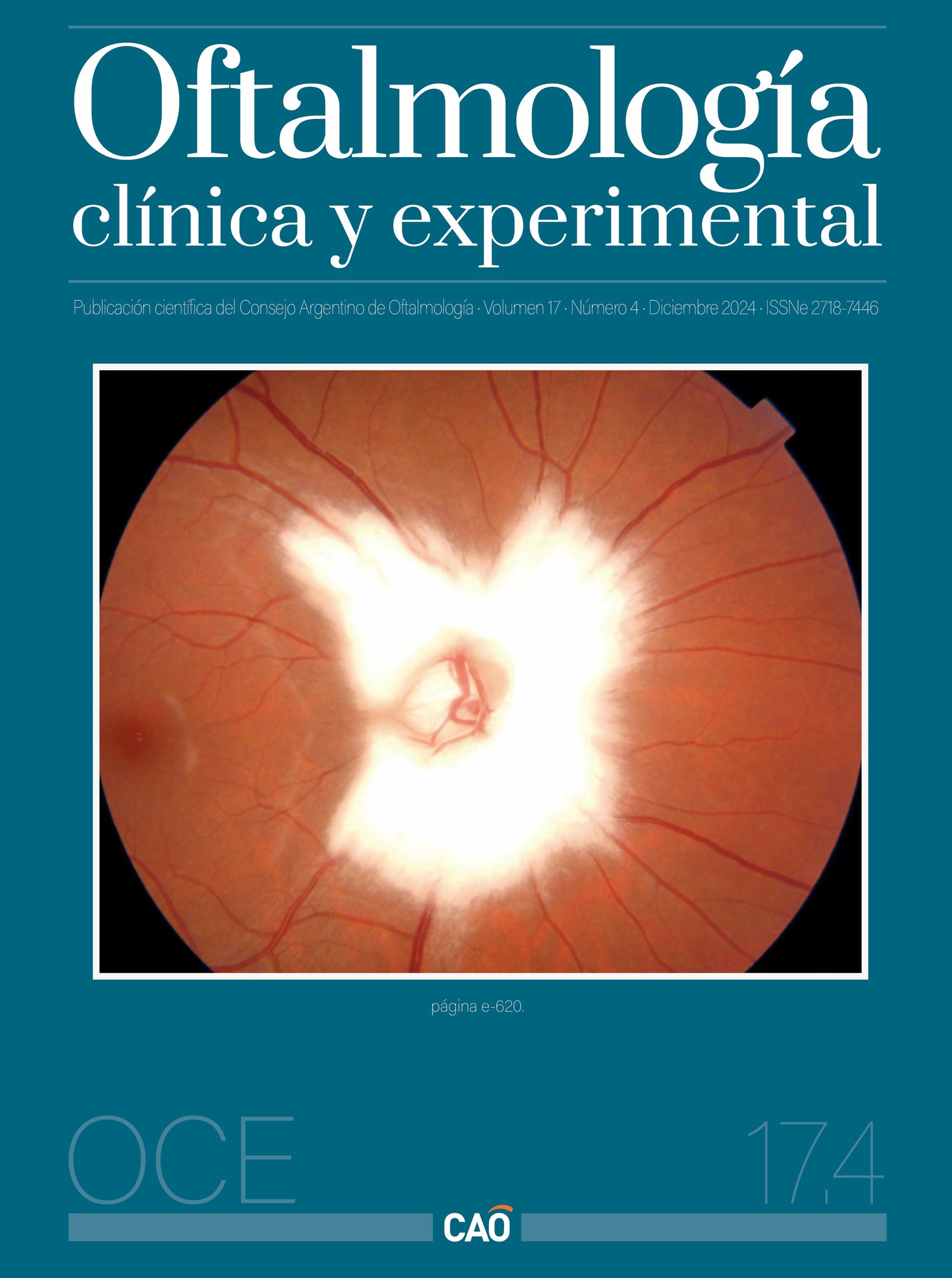Acquired nasolacrimal duct obstruction
a retrospective study
DOI:
https://doi.org/10.70313/2718.7446.v17.n04.379Keywords:
nasolacrimal duct obstruction, epiphora, lacrimal ductAbstract
Objective. To evaluate the predisposing causes of acquired nasolacrimal duct obstruction in a population of patients from Rosario, Argentina.
Materials and methods. A retrospective study of a case series with a diagnosis of acquired nasolacrimal duct obstruction, attended at the Centro Oftalmológico Francia Rosario (Santa Fe, Argentina) from January to June 2024, was performed. In each case we reviewed information related to sex, age, sinus disease, trauma, palpebral malposition, related chronic inflammatory disease (Sarcoidosis, Wegener among others), previous nasal surgery and neoplasms of the nasolacrimal region.
Results. Twenty cases were included, 65% women. The mean age was 64.4 ±9.5 years (48-85), where the majority (75%) were older than 60 years. Regarding risk factors, 20% had a history of previous nasal surgery, 15% were associated with sinus pathology, another 15% with eyelid malposition, 10% with a history of trauma, and only one case was due to neoplasia.
Conclusion. The most frequent predisposing causes of acquired nasolacrimal duct obstruction were mainly female sex and age, followed by a history of sinus disease and previous nasal surgery. Problems related to eyelids, trauma and tumors were found in fewer cases.
Downloads
References
Nair JR, Syed R, Chan IYM, Gorelik N, Chankowsky J, Del Carpio-O’Donovan R. The forgotten lacrimal gland and lacrimal drainage apparatus: pictorial review of CT and MRI findings and differential diagnosis. Br J Radiol 2022; 95(1135): 20211333. doi:10.1259/bjr.20211333.
Maliborski A, Różycki R. Diagnostic imaging of the nasolacrimal drainage system. Part I. Radiological anatomy of lacrimal pathways. Physiology of tear secretion and tear outflow. Med Sci Monit 2014; 20: 628-638. doi:10.12659/MSM.890098.
Weil D, Aldecoa JP, Heidenreich AM. Diseases of the lacrimal drainage system. Curr Opin Ophthalmol 2001; 12(5): 352-356. doi:10.1097/00055735-200110000-00005.
Lee JM, Baek JS. Etiology of epiphora. Korean J Ophthalmol 2021; 35(5): 349-354. doi:10.3341/kjo.2021.0069.
Ceylanoglu KS, Acar A, Sen E. Overview of epiphora referred to oculoplastic surgery clinic in adults. Beyoglu Eye J 2023; 8(1): 45-49. doi:10.14744/bej.2023.38980.
Blackmore KJ, Ainsworth G, Robson AK. Epiphora: an evidence based approach to the 12 minute consultation. Clin Otolaryngol 2010; 35(3): 210-214. doi:10.1111/j.1749-4486.2010.02138.x.
Shin JH, Kim YD, Woo KI; Korean Society of Ophthalmic Plastic and Reconstructive Surgery (KSOPRS). Impact of epiphora on vision-related quality of life. BMC Ophthalmol 2015; 15: 6. doi:10.1186/1471-2415-15-6.
Usmani E, Shapira Y, Selva D. Functional epiphora: an under-reported entity. Int Ophthalmol 2023; 43(8): 2687-2693. doi:10.1007/s10792-023-02668-4.
Avdagic E, Phelps PO. Nasolacrimal duct obstruction as an important cause of epiphora. Dis Mon 2020; 66(10): 101043. doi:10.1016/j.disamonth.2020.101043.
Ali MJ. Etiopathogenesis of primary acquired nasolacrimal duct obstruction (PANDO). Prog Retin Eye Res 2023; 96: 101193. doi:10.1016/j.preteyeres.2023.101193.
Makselis A, Petroska D, Kadziauskiene A, et al. Acquired nasolacrimal duct obstruction: clinical and histological findings of 275 cases. BMC Ophthalmol 2022; 22(1): 12. doi:10.1186/s12886-021-02185-x.
Dag Y, Acet Y. The role of systemic inflammation in acquired nasolacrimal duct obstruction. Beyoglu Eye J 2023; 8(4): 260-265. doi:10.14744/bej.2023.92259.
Czyz CN, Bacon TS, Stacey AW, et al. Nasolacrimal system aeration on computed tomographic imaging: sex and age variation. Ophthalmic Plast Reconstr Surg 2016; 32(1): 11-16. doi:10.1097/IOP.0000000000000392.
Ohtomo K, Ueta T, Toyama T, Nagahara M. Predisposing factors for primary acquired nasolacrimal duct obstruction. Graefes Arch Clin Exp Ophthalmol 2013; 251(7): 1835-1839. doi:10.1007/s00417-013-2288-5.
Downloads
Published
Issue
Section
License
Copyright (c) 2024 Consejo Argentino de Oftalmología

This work is licensed under a Creative Commons Attribution-NonCommercial-NoDerivatives 4.0 International License.
Con esta licencia no se permite un uso comercial de la obra original, ni la generación de obras derivadas. Las licencias Creative Commons permiten a los autores compartir y liberar sus obras en forma legal y segura.







